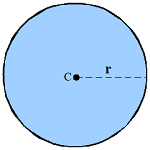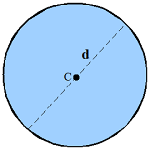Our very last standard 2-dimensional figure to consider is in so very many respects the most fascinating. That would be the circle — defined as the set of all points "equidistant" from a fixed point referred to as the center (point C in the illustration).

For a circle, the two important formulas are:
| & | ||||
| or | πd where d = diameter | |||
through the circle's center (point C in the figure).

Having now rummaged
|
to hastily examine or search |
|---|
*π ≈ 3.14159 is a non-terminating, non-repeating decimal (i.e., an irrational number) and a transcendental number